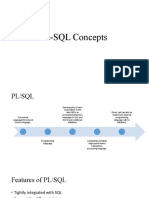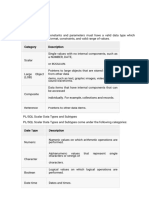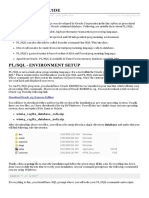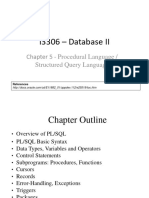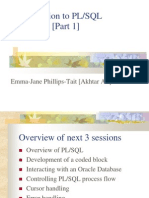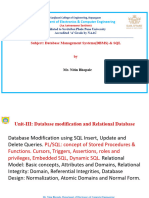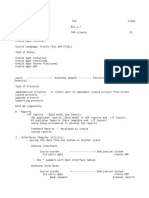Unit 3 Rdbms
Uploaded by
funhindi4Unit 3 Rdbms
Uploaded by
funhindi4Relational Database Management System
PL/SQL Introduction
PL/SQL is a block structured language that enables developers to combine the power of
SQL with procedural statements. All the statements of a block are passed to oracle engine
all at once which increases processing speed and decreases the traffic.
Basics of PL/SQL
● PL/SQL stands for Procedural Language extensions to the Structured Query
Language (SQL).
● PL/SQL is a combination of SQL along with the procedural features of
programming languages.
● Oracle uses a PL/SQL engine to processes the PL/SQL statements.
● PL/SQL includes procedural language elements like conditions and loops. It
allows declaration of constants and variables, procedures and functions, types
and variable of those types and triggers.
Features of PL/SQL
PL/SQL has the following features −
● PL/SQL is tightly integrated with SQL.
● It offers extensive error checking mechanisms.
● It supports numerous data types for flexible data handling.
● Includes a variety of programming structures, such as loops and conditionals.
● It supports structured programming through functions and procedures.
● It supports object-oriented programming, enabling more complex data handling
and manipulation.
● It supports the web application development and server pages.
Miss. Hemangi Panchal Page 1
Relational Database Management System
Differences between SQL and PL/SQL:
SQL PL/SQL
PL/SQL is a block of codes that used
SQL is a single query that is used to
to write the entire program blocks/
perform DML and DDL operations.
procedure/ function, etc.
It is declarative, that defines what needs
PL/SQL is procedural that defines
to be done, rather than how things need to
how the things needs to be done.
be done.
Execute as a single statement. Execute as a whole block.
Mainly used to manipulate data. Mainly used to create an application.
It is an extension of SQL, so it can
Cannot contain PL/SQL code in it.
contain SQL inside it.
Miss. Hemangi Panchal Page 2
Relational Database Management System
PL\SQL-Introduction
PL-SQL (Procedural - SQL)
➔ Function
➔ Procedure
➔ Trigger
➔ Cursor
The sections of a PL/SQL block are:
1. The Declare section
2. The master Begin and End section that also (optionally) contains as Exception
section.
PL/SQL block of code
Declare
Procedural Statements;
Begin
Procedural Statements;
SQL statements;
Exceptions
SQL statements;
END;
PL/SQL Data Types
In this chapter, we will discuss the Data Types in PL/SQL. The PL/SQL variables,
constants and parameters must have a valid data type, which specifies a storage format,
constraints, and a valid range of values. We will focus on the SCALAR and the LOB data
types in this chapter. The other two data types will be covered in other chapters.
S.No Category & Description
Scalar
1 Single values with no internal components, such as a NUMBER, DATE, or
BOOLEAN.
Miss. Hemangi Panchal Page 3
Relational Database Management System
Large Object (LOB)
Pointers to large objects that are stored separately from other data items,
2 such as text, graphic images, video clips, and sound waveforms.
Composite
3 Data items that have internal components that can be accessed individually.
For example, collections and records.
Reference
4 Pointers to other data items.
PL/SQL Scalar Data Types and Subtypes
PL/SQL Scalar Data Types and Subtypes come under the following categories −
S.No Date Type & Description
Numeric
1 Numeric values on which arithmetic operations are performed.
Character
2 Alphanumeric values that represent single characters or strings of characters.
Boolean
3 Logical values on which logical operations are performed.
Datetime
4 Dates and times.
PL/SQL provides subtypes of data types. For example, the data type NUMBER has a
subtype called INTEGER. You can use the subtypes in your PL/SQL program to make
the data types compatible with data types in other programs while embedding the PL/SQL
code in another program, such as a Java program.
Miss. Hemangi Panchal Page 4
Relational Database Management System
PL/SQL Numeric Data Types and Subtypes
Following table lists out the PL/SQL pre-defined numeric data types and their sub-types
S.No Data Type & Description
PLS_INTEGER
1 Signed integer in range -2,147,483,648 through 2,147,483,647, represented
in 32 bits
BINARY_INTEGER
2 Signed integer in range -2,147,483,648 through 2,147,483,647, represented
in 32 bits
BINARY_FLOAT
3 Single-precision IEEE 754-format floating-point number
BINARY_DOUBLE
4 Double-precision IEEE 754-format floating-point number
NUMBER(prec, scale)
Fixed-point or floating-point number with absolute value in range 1E-130 to
5 (but not including) 1.0E126. A NUMBER variable can also represent 0
DEC(prec, scale)
6 ANSI specific fixed-point type with maximum precision of 38 decimal digits
DECIMAL(prec, scale)
7 IBM specific fixed-point type with maximum precision of 38 decimal digits
NUMERIC(pre, secale)
8 Floating type with maximum precision of 38 decimal digits
Miss. Hemangi Panchal Page 5
Relational Database Management System
DOUBLE PRECISION
9 ANSI specific floating-point type with maximum precision of 126 binary digits
(approximately 38 decimal digits)
FLOAT
10 ANSI and IBM specific floating-point type with maximum precision of 126
binary digits (approximately 38 decimal digits)
INT
11 ANSI specific integer type with maximum precision of 38 decimal digits
INTEGER
12 ANSI and IBM specific integer type with maximum precision of 38 decimal
digits
SMALLINT
13 ANSI and IBM specific integer type with maximum precision of 38 decimal
digits
REAL
14 Floating-point type with maximum precision of 63 binary digits (approximately
18 decimal digits)
Following is a valid declaration −
DECLARE
num1 INTEGER;
num2 REAL;
num3 DOUBLE PRECISION;
BEGIN
null;
END;
/
When the above code is compiled and executed, it produces the following result −
PL/SQL procedure successfully completed
Miss. Hemangi Panchal Page 6
Relational Database Management System
PL/SQL Character Data Types and Subtypes
Following is the detail of PL/SQL pre-defined character data types and their sub-types −
S.No Data Type & Description
CHAR
1 Fixed-length character string with maximum size of 32,767 bytes
VARCHAR2
2 Variable-length character string with maximum size of 32,767 bytes
RAW
3 Variable-length binary or byte string with maximum size of 32,767 bytes, not
interpreted by PL/SQL
NCHAR
4 Fixed-length national character string with maximum size of 32,767 bytes
NVARCHAR2
5 Variable-length national character string with maximum size of 32,767 bytes
LONG
6 Variable-length character string with maximum size of 32,760 bytes
LONG RAW
7 Variable-length binary or byte string with maximum size of 32,760 bytes, not
interpreted by PL/SQL
ROWID
8 Physical row identifier, the address of a row in an ordinary table
UROWID
9 Universal row identifier (physical, logical, or foreign row identifier)
Miss. Hemangi Panchal Page 7
Relational Database Management System
PL/SQL Boolean Data Types
The BOOLEAN data type stores logical values that are used in logical operations. The
logical values are the Boolean values TRUE and FALSE and the value NULL.
However, SQL has no data type equivalent to BOOLEAN. Therefore, Boolean values
cannot be used in −
SQL statements
Built-in SQL functions (such as TO_CHAR)
PL/SQL functions invoked from SQL statements
PL/SQL Datetime and Interval Types
The DATE datatype is used to store fixed-length datetimes, which include the time of day
in seconds since midnight. Valid dates range from January 1, 4712 BC to December 31,
9999 AD.
The default date format is set by the Oracle initialization parameter
NLS_DATE_FORMAT. For example, the default might be 'DD-MON-YY', which includes
a two-digit number for the day of the month, an abbreviation of the month name, and the
last two digits of the year. For example, 01-OCT-12.
Each DATE includes the century, year, month, day, hour, minute, and second. The
following table shows the valid values for each field −
Field Name Valid Datetime Values Valid Interval
Values
-4712 to 9999 (excluding year 0)
YEAR Any nonzero integer
MONTH 01 to 12 0 to 11
Miss. Hemangi Panchal Page 8
Relational Database Management System
01 to 31 (limited by the values of
MONTH and YEAR, according to the
DAY rules of the calendar for the locale) Any nonzero integer
HOUR 00 to 23 0 to 23
MINUTE 00 to 59 0 to 59
00 to 59.9(n), where 9(n) is the 0 to 59.9(n), where
precision of time fractional seconds 9(n) is the precision
SECOND of interval fractional
seconds
-12 to 14 (range accommodates
TIMEZONE_HOUR daylight savings time changes) Not applicable
TIMEZONE_MINUTE 00 to 59 Not applicable
TIMEZONE_REGIO Found in the dynamic performance
view V$TIMEZONE_NAMES Not applicable
N
Found in the dynamic performance
TIMEZONE_ABBR view V$TIMEZONE_NAMES Not applicable
PL/SQL Large Object (LOB) Data Types
Large Object (LOB) data types refer to large data items such as text, graphic images,
video clips, and sound waveforms. LOB data types allow efficient, random, piecewise
access to this data. Following are the predefined PL/SQL LOB data types −
Data Type Description Size
Miss. Hemangi Panchal Page 9
Relational Database Management System
Used to store large binary objects in System-dependent. Cannot
BFILE operating system files outside the exceed 4 gigabytes (GB).
database.
Used to store large binary objects in 8 to 128 terabytes (TB)
BLOB the database.
Used to store large blocks of 8 to 128 TB
CLOB character data in the database.
Used to store large blocks of NCHAR 8 to 128 TB
NCLOB data in the database.
PL/SQL User-Defined Subtypes
A subtype is a subset of another data type, which is called its base type. A subtype has
the same valid operations as its base type, but only a subset of its valid values.
PL/SQL predefines several subtypes in package STANDARD. For example, PL/SQL
predefines the subtypes CHARACTER and INTEGER as follows −
SUBTYPE CHARACTER IS CHAR;
SUBTYPE INTEGER IS NUMBER(38,0);
You can define and use your own subtypes. The following program illustrates defining
and using a user-defined subtype −
DECLARE
SUBTYPE name IS char(20);
SUBTYPE message IS varchar2(100);
salutation name;
greetings message;
BEGIN
salutation := 'Reader ';
greetings := 'Welcome to the World of PL/SQL';
dbms_output.put_line('Hello ' || salutation || greetings);
Miss. Hemangi Panchal Page 10
Relational Database Management System
END;
/
When the above code is executed at the SQL prompt, it produces the following result −
Hello Reader Welcome to the World of PL/SQL
PL/SQL procedure successfully completed.
NULLs in PL/SQL
PL/SQL NULL values represent missing or unknown data and they are not an integer,
a character, or any other specific data type. Note that NULL is not the same as an empty
data string or the null character value '\0'. A null can be assigned but it cannot be equated
with anything, including itself.
PL/SQL - Basic Syntax
Basic Syntax of PL/SQL which is a block-structured language; this means that the
PL/SQL programs are divided and written in logical blocks of code. Each block consists
of three sub-parts −
S.N Sections & Description
o
Declarations
This section starts with the keyword DECLARE. It is an optional
1
section and defines all variables, cursors, subprograms, and other
elements to be used in the program.
Miss. Hemangi Panchal Page 11
Relational Database Management System
Executable Commands
This section is enclosed between the keywords BEGIN and END
and it is a mandatory section. It consists of the executable PL/SQL
2
statements of the program. It should have at least one executable
line of code, which may be just a NULL command to indicate that
nothing should be executed.
Exception Handling
3 This section starts with the keyword EXCEPTION. This optional
section contains exception(s) that handle errors in the program.
Every PL/SQL statement ends with a semicolon (;). PL/SQL blocks can be
nested within other PL/SQL blocks using BEGIN and END. Following is the basic
structure of a PL/SQL block −
DECLARE
<declarations section>
BEGIN
<executable command(s)>
EXCEPTION
<exception handling>
END;
The 'Hello World' Example
SET SERVEROUTPUT ON;
DECLARE
message varchar2(20):= 'Hello, World!';
BEGIN
dbms_output.put_line(message);
END;
/
Miss. Hemangi Panchal Page 12
Relational Database Management System
The end; line signals the end of the PL/SQL block. To run the code from the SQL
command line, you may need to type / at the beginning of the first blank line after the last
line of the code. When the above code is executed at the SQL prompt, it produces the
following result −
Hello World
PL/SQL procedure successfully completed.
The PL/SQL Identifiers
PL/SQL identifiers are constants, variables, exceptions, procedures, cursors,
and reserved words. The identifiers consist of a letter optionally followed by
more letters, numerals, dollar signs, underscores, and number signs and
should not exceed 30 characters.
By default, identifiers are not case-sensitive. So you can use integer or
INTEGER to represent a numeric value. You cannot use a reserved keyword
as an identifier.
The PL/SQL Delimiters
A delimiter is a symbol with a special meaning. Following is the list of delimiters in PL/SQL
Delimiter Description
+, -, *, / Addition, subtraction/negation, multiplication, division
% Attribute indicator
Miss. Hemangi Panchal Page 13
Relational Database Management System
' Character string delimiter
. Component selector
(,) Expression or list delimiter
: Host variable indicator
, Item separator
" Quoted identifier delimiter
= Relational operator
@ Remote access indicator
; Statement terminator
:= Assignment operator
=> Association operator
|| Concatenation operator
** Exponentiation operator
<<, >> Label delimiter (begin and end)
/*, */ Multi-line comment delimiter (begin and end)
-- Single-line comment indicator
Miss. Hemangi Panchal Page 14
Relational Database Management System
.. Range operator
<, >, <=, >= Relational operators
<>, '=, ~=, ^= Different versions of NOT EQUAL
The PL/SQL Comments
Program comments are explanatory statements that can be included in the
PL/SQL code that you write and helps anyone reading its source code. All
programming languages allow some form of comments.
The PL/SQL supports single-line and multi-line comments. All characters
available inside any comment are ignored by the PL/SQL compiler. The PL/SQL
single-line comments start with the delimiter -- (double hyphen) and multi-
line comments are enclosed by /* and */.
DECLARE
-- variable declaration
message varchar2(20):= 'Hello, World!';
BEGIN
/*
* PL/SQL executable statement(s)
*/
dbms_output.put_line(message);
END;
/
When the above code is executed at the SQL prompt, it produces the following result −
Hello World
PL/SQL procedure successfully completed.
Miss. Hemangi Panchal Page 15
Relational Database Management System
Block Structure
PL/SQL block structure consists of three main sections: declarative, executable, and
exception-handling sections. The structure can be divided into:
1. Declarative Section: This section is optional. Here, variables, constants,
cursors, and types are declared.
2. Executable Section: This is the mandatory section. It contains the executable
code and logic.
3. Exception-Handling Section: This section is optional. It handles exceptions
(runtime errors).
Basic PL/SQL Block Structure:
DECLARE
-- Declarative section (optional)
-- Variable, constant, cursor declarations, etc.
variable_name datatype [NOT NULL] := value;
constant_name CONSTANT datatype := value;
BEGIN
-- Executable section (mandatory)
-- Code to be executed
DBMS_OUTPUT.PUT_LINE('Executable code goes here');
-- Variable manipulation and processing logic
variable_name := some_value;
EXCEPTION
-- Exception-handling section (optional)
-- Code to handle errors
WHEN exception_name THEN
-- Actions to perform when the exception is raised
DBMS_OUTPUT.PUT_LINE('An error occurred: ' || SQLERRM);
-- You can handle multiple exceptions
WHEN OTHERS THEN
DBMS_OUTPUT.PUT_LINE('A general error occurred');
END;
/
Miss. Hemangi Panchal Page 16
Relational Database Management System
Breakdown of Each Section:
1. DECLARE (optional): This is where variables and constants are declared. If
there are no declarations, you can omit this section entirely.
DECLARE
counter NUMBER := 0;
greeting VARCHAR2(20) := 'Hello, PL/SQL!';
2. BEGIN (mandatory): The main executable code goes here. This is where the
logic and operations are performed.
BEGIN
DBMS_OUTPUT.PUT_LINE(greeting);
counter := counter + 1;
3. EXCEPTION (optional): This section is used to handle errors. PL/SQL exceptions can
be predefined or user-defined.
EXCEPTION
WHEN NO_DATA_FOUND THEN
DBMS_OUTPUT.PUT_LINE('No data found.');
WHEN OTHERS THEN
DBMS_OUTPUT.PUT_LINE('An unexpected error occurred.');
Example of a Complete PL/SQL Block:
DECLARE
v_num NUMBER := 5;
BEGIN
IF v_num > 0 THEN
DBMS_OUTPUT.PUT_LINE('The number is positive.');
END IF;
EXCEPTION
WHEN OTHERS THEN
DBMS_OUTPUT.PUT_LINE('An error occurred.');
END;
/
When the above code is executed at the SQL prompt, it produces the following result −
Miss. Hemangi Panchal Page 17
Relational Database Management System
The number is positive.
PL/SQL procedure successfully completed.
In this example:
● The declarative section declares a variable v_num.
● The executable section checks if v_num is positive.
● The exception section handles any potential errors.
Conditional Statements in PL / SQL
In many case we would be in a state whether we have to choose Yes or No. These types
of questions are also called Decision Statements. Here, the user is compelled to choose
one answer. In this case we choose the answer based on the condition in which we are
present. In the same way, Every Program has its moments like choosing if this condition
is positive then we choose Yes statement else if condition is false then we choose No
statement while coding.
The Every Programming Language has a few Conditional statements. These Conditional
statements are also known as Decision Statements. There are a few Conditional
Miss. Hemangi Panchal Page 18
Relational Database Management System
Statements or Decision Statements in PL / SQL (Procedure Language / Structured Query
Language).
The Conditional Statements can only be used in BEGIN State.
Types of Conditional Statements
1. if condition then statement
2. if condition then else statement
3. nested if condition then statements
4. if condition then elseif condition then else statements
1.) if Condition then Statement
This is one of the first important PL / SQL Conditional Statement. In this statement only
if the condition is true, then the output is going to be shown. Else in any other cases there
is no opportunity for outputs.
Syntax :
IF <condition> then
Statement 1
Statement 2
Statement N
END IF;
Example :
SQL> DECLARE
N1 INTEGER;
BEGIN
N1 := 10;
IF N1 >= 10 THEN
Miss. Hemangi Panchal Page 19
Relational Database Management System
dbms_output.put_line('The Value is ' || N1);
END IF;
EXCEPTION
WHEN OTHERS THEN
DBMS_OUTPUT.PUT_LINE('ERROR');
END;
OUTPUT:
The Value is 10
PL/SQL procedure successfully completed.
2.) if Condition then else Statement
This is also one of the first important PL / SQL Conditional Statement. In this statement
only if the condition is true, then the output is going to be shown. Else in any other cases
there is opportunity for outputs to seen. If the if condition fails then the else statements
are executed.
This means if condition is true If statements are executed. If not possible else statements
are executed.
This kind of conditional statements are required for finding few real life problems like
finding odd or even number, Checking the number is divisible by two, three, etc., Finding
Largest Number, Finding Smallest Number, etc. many programs like this.
Syntax
IF >CONDITION> THEN
Statement 1
Statement 2
Miss. Hemangi Panchal Page 20
Relational Database Management System
Statement N
ELSE
Statement 1
Statement 2
Statement N
END IF;
Example:
SQL> DECLARE
N1 INTEGER;
N2 INTEGER;
BEGIN
N1:=10;
N2:=5;
IF N1 > N2 THEN
dbms_output.put_line('The Values of N1 is greater than N2');
ELSE
dbms_output.put_line('The Values of N2 is greater than N1');
END IF;
END;
Miss. Hemangi Panchal Page 21
Relational Database Management System
OUTPUT :
The Values of N1 is greater than N2
PL/SQL procedure successfully completed.
3.) if condition elsif condition else statements
This is also one of the first important PL / SQL Conditional Statement. In this statement
only if the condition is true, then the output is going to be shown. Else in any other cases
there is opportunity for outputs to seen. If the if condition fails then the else if statements
with a condition are executed. Even if else if condition is False, then the else statements
are executed.
Syntax
IF <CONDITION> THEN
Statement 1
Statement 2
Statement N
ELSEIF <CONDITION> THEN
Statement 1
Statement 2
Statement N
ELSE
Statement 1
Statement 2
Miss. Hemangi Panchal Page 22
Relational Database Management System
Statement N
END IF;
Example
SQL> SET SERVEROUTPUT ON;
SQL> DECLARE
num1 INTEGER:= 7;
num2 INTEGER:= 8;
BEGIN
IF num1 > num2 THEN
dbms_output.put_line('NUM1 SMALLER THAN NUM2');
ELSIF num1 = num2 THEN
dbms_output.put_line('EQUAL');
ELSE
dbms_output.put_line('NUM2 SMALLER THAN NUM1');
END IF;
END;
Output:
NUM2 SMALLER THAN NUM1
PL/SQL procedure successfully completed.
Miss. Hemangi Panchal Page 23
Relational Database Management System
4.) Nested if condition then statements
This is also one of the conditional statements used in PL / SQL. Here, we are going to
write the same if else statements. But in place of if statements we are going to write
another if condition else statements. The workings of these statements are same and
similar to the previous if else statements.
Syntax
Syntax 1
IF <CONDITION> THEN
IF <CONDITION> THEN
Statement 1
Statement 2
Statement N
ELSE
Statement 1
Statement 2
Statement N
END IF;
ELSE
Statement 1
Statement 2
Statement N
END IF;
Syntax 2:
Miss. Hemangi Panchal Page 24
Relational Database Management System
IF <CONDITION> THEN
Statement 1
Statement 2
Statement N
ELSE
IF <CONDITION> THEN
Statement 1
Statement 2
Statement N
ELSE
Statement 1
Statement 2
Statement N
END IF;
END IF;
Example
SQL> DECLARE
num1 INTEGER;
num2 INTEGER;
Miss. Hemangi Panchal Page 25
Relational Database Management System
num3 INTEGER;
BEGIN
num1:= 17;
num2:= 12;
num3:= 10;
IF num1 > num2 THEN
IF num1 > num3 THEN
dbms_output.put_line('The greatest number is '|| num1);
END IF;
ELSIF num2 > num3 THEN
dbms_output.put_line('The greatest number is '|| num2);
ELSE
dbms_output.put_line('The greatest number is '|| num3);
END IF;
END;
Output:
The greatest number is 17
PL/SQL procedure successfully completed.
Miss. Hemangi Panchal Page 26
Relational Database Management System
PL/SQL Loops
There may be a situation when you need to execute a block of code several number of
times. In general, statements are executed sequentially: The first statement in a function
is executed first, followed by the second, and so on.
Programming languages provide various control structures that allow for more
complicated execution paths.
A loop statement allows us to execute a statement or group of statements multiple times
and following is the general form of a loop statement in most of the programming
languages −
PL/SQL provides the following types of loop to handle the looping requirements.
1. Basic Loop
2. While Loop
3. For Loop
Miss. Hemangi Panchal Page 27
Relational Database Management System
We will learn about all three of them while covering the concept of nexted loops which
means loop inside a loop. So let's get started.
PL/SQL Basic Loop
Basic loop or simple loop is preferred in PL/SQL code when there is no surety about how
many times the block of code is to be repeated. When we use the basic loop the code
block will be executed at least once.
While using it, following two things must be considered:
● Simple loop always begins with the keyword LOOP and ends with a keyword
END LOOP.
● A basic/simple loop can be terminated at any given point by using the exit
statement or by specifying certain condition by using the statement exit when.
Syntax:
LOOP
sequence of statements
END LOOP;
Let's see the simple loop in action in the code example below.
Example
We have used the loop to print counting from 1 to 10 on the console and have used the
exit statement to break out of the loop.
SQL> set serveroutput on;
SQL> DECLARE
i int;
Miss. Hemangi Panchal Page 28
Relational Database Management System
BEGIN
i := 1;
LOOP
if i>10 then
exit;
end if;
dbms_output.put_line(i);
i := i+1;
END LOOP;
END;
Output:
10
PL/SQL procedure successfully completed
Let's take one more example where we will be using the exit when statement to break out
of the loop.
SQL> set serveroutput on;
Miss. Hemangi Panchal Page 29
Relational Database Management System
SQL> DECLARE
i int;
BEGIN
i := 0;
LOOP
i := i+2;
dbms_output.put_line(i);
exit WHEN i > 10;
END LOOP;
END;
Output :
10
PL/SQL procedure successfully completed
PL/SQL: While Loop
It is an entry controlled loop which means that before entering in a while loop first the
condition is tested, if the condition is TRUE the statement or a group of statements get
executed and if the condition is FALSE the control will move out of the while loop.
Syntax:
WHILE <test_condition> LOOP
<action>
END LOOP;
Miss. Hemangi Panchal Page 30
Relational Database Management System
Let's see the while loop in action in the code example below.
Example :
Below we have a simple program to print the odd numbers between 1 to 10 using the
while loop.
SQL> set serveroutput on;
SQL> DECLARE
num int:=1;
BEGIN
while(num <= 10) LOOP
dbms_output.put_line(''|| num);
num := num+2;
END LOOP;
END;
Output :
PL/SQL procedure successfully completed.
NOTE: You must write the code to increment the value of the variable that you put in the
condition otherwise the value of the variable will remain the same and the condition will
always remain true.
PL/SQL: For Loop
Miss. Hemangi Panchal Page 31
Relational Database Management System
This loop is used when some statements in PL/SQL code block are to be repeated for a
fixed number of times.
When we use the for loop we are supposed to define a counter variable which decides
how many time the loop will be executed based on a starting and ending value provided
at the beginning of the loop.
The for loop automatically increments the value of the counter variable by 1 at the end of
each loop cycle.
The programmer need not have to write any instruction for incrementing or decrementing
value.
Syntax:
FOR counter_variable IN start_value..end_value LOOP
statement to be executed
END LOOP;
Example :
In the example below we have used a the for loop to print numbers from 1 to 10.
SQL> set serveroutput on;
SQL> DECLARE
i number(2);
BEGIN
FOR i IN 1..10 LOOP
dbms_output.put_line(i);
END LOOP;
END;
Output:
Miss. Hemangi Panchal Page 32
Relational Database Management System
10
PL/SQL procedure successfully completed.
Cursors
When an SQL statement is processed, Oracle creates a memory area known as context
area. A cursor is a pointer to this context area. It contains all information needed for
processing the statement. In PL/SQL, the context area is controlled by Cursor. A cursor
contains information on a select statement and the rows of data accessed by it.
A cursor is used to referred to a program to fetch and process the rows returned by the
SQL statement, one at a time. There are two types of cursors:
● Implicit Cursors
● Explicit Cursors
1) PL/SQL Implicit Cursors
The implicit cursors are automatically generated by Oracle while an SQL statement is
executed, if you don't use an explicit cursor for the statement.
Miss. Hemangi Panchal Page 33
Relational Database Management System
These are created by default to process the statements when DML statements like
INSERT, UPDATE, DELETE etc. are executed.
Oracle provides some attributes known as Implicit cursor's attributes to check the status
of DML operations. Some of them are: %FOUND, %NOTFOUND, %ROWCOUNT and
%ISOPEN.
For example: When you execute the SQL statements like INSERT, UPDATE, DELETE
then the cursor attributes tell whether any rows are affected and how many have been
affected. If you run a SELECT INTO statement in PL/SQL block, the implicit cursor
attribute can be used to find out whether any row has been returned by the SELECT
statement. It will return an error if there no data is selected.
The following table specifies the status of the cursor with each of its attribute.
Attribute Description
%FOUND Its return value is TRUE if DML statements like INSERT, DELETE
and UPDATE affect at least one row or more rows or a SELECT
INTO statement returned one or more rows. Otherwise it returns
FALSE.
%NOTFOUND Its return value is TRUE if DML statements like INSERT, DELETE
and UPDATE affect no row, or a SELECT INTO statement return no
rows. Otherwise it returns FALSE. It is a just opposite of %FOUND.
%ISOPEN It always returns FALSE for implicit cursors, because the SQL
cursor is automatically closed after executing its associated SQL
statements.
Miss. Hemangi Panchal Page 34
Relational Database Management System
%ROWCOUNT It returns the number of rows affected by DML statements like
INSERT, DELETE, and UPDATE or returned by a SELECT INTO
statement.
PL/SQL Implicit Cursor Example
Create customers table and have records:
ID NAME AGE ADDRESS SALARY
1 Ramesh 23 Allahabad 20000
2 Suresh 22 Kanpur 22000
3 Mahesh 24 Ghaziabad 24000
4 Chandan 25 Noida 26000
5 Alex 21 Paris 28000
6 Sunita 20 Delhi 30000
Let's execute the following program to update the table and increase salary of each
customer by 5000. Here, SQL%ROWCOUNT attribute is used to determine the number
of rows affected:
Create procedure:
Miss. Hemangi Panchal Page 35
Relational Database Management System
DECLARE
total_rows number(2);
BEGIN
UPDATE customers
SET salary = salary + 5000;
IF sql%notfound THEN
dbms_output.put_line('no customers updated');
ELSIF sql%found THEN
total_rows := sql%rowcount;
dbms_output.put_line( total_rows || ' customers updated ');
END IF;
END;
Output:
6 customers updated
PL/SQL procedure successfully completed.
Now, if you check the records in customer table, you will find that the rows are updated.
select * from customers;
Miss. Hemangi Panchal Page 36
Relational Database Management System
ID NAME AGE ADDRESS SALARY
1 Ramesh 23 Allahabad 25000
2 Suresh 22 Kanpur 27000
3 Mahesh 24 Ghaziabad 29000
4 Chandan 25 Noida 31000
5 Alex 21 Paris 33000
6 Sunita 20 Delhi 35000
2) PL/SQL Explicit Cursors
The Explicit cursors are defined by the programmers to gain more control over the context
area. These cursors should be defined in the declaration section of the PL/SQL block. It
is created on a SELECT statement which returns more than one row.
Following is the syntax to create an explicit cursor:
Syntax of explicit cursor
Following is the syntax to create an explicit cursor:
CURSOR cursor_name IS select_statement;
Steps:
Miss. Hemangi Panchal Page 37
Relational Database Management System
You must follow these steps while working with an explicit cursor.
1. Declare the cursor to initialize in the memory.
2. Open the cursor to allocate memory.
3. Fetch the cursor to retrieve data.
4. Close the cursor to release allocated memory.
1) Declare the cursor:
It defines the cursor with a name and the associated SELECT statement.
Syntax for explicit cursor declaration
CURSOR name IS
SELECT statement;
2) Open the cursor:
It is used to allocate memory for the cursor and make it easy to fetch the rows returned
by the SQL statements into it.
Syntax for cursor open:
OPEN cursor_name;
3) Fetch the cursor:
It is used to access one row at a time. You can fetch rows from the above-opened cursor
as follows:
Syntax for cursor fetch:
FETCH cursor_name INTO variable_list;
4) Close the cursor:
Miss. Hemangi Panchal Page 38
Relational Database Management System
It is used to release the allocated memory. The following syntax is used to close the
above-opened cursors.
Syntax for cursor close:
Close cursor_name;
PL/SQL Explicit Cursor Example
Explicit cursors are defined by programmers to gain more control over the context area.
It is defined in the declaration section of the PL/SQL block. It is created on a SELECT
statement which returns more than one row.
Let's take an example to demonstrate the use of explicit cursor. In this example, we are
using the already created CUSTOMERS table.
Create customers table and have records:
ID NAME AGE ADDRESS SALARY
1 Ramesh 23 Allahabad 20000
2 Suresh 22 Kanpur 22000
3 Mahesh 24 Ghaziabad 24000
4 Chandan 25 Noida 26000
Miss. Hemangi Panchal Page 39
Relational Database Management System
5 Alex 21 Paris 28000
6 Sunita 20 Delhi 30000
Create procedure:
Execute the following program to retrieve the customer name and address.
DECLARE
c_id customers.id%type;
c_name customers.name%type;
c_addr customers.address%type;
CURSOR c_customers is
SELECT id, name, address FROM customers;
BEGIN
OPEN c_customers;
LOOP
FETCH c_customers into c_id, c_name, c_addr;
EXIT WHEN c_customers%notfound;
dbms_output.put_line(c_id || ' ' || c_name || ' ' || c_addr);
END LOOP;
CLOSE c_customers;
END;
Miss. Hemangi Panchal Page 40
Relational Database Management System
Output:
1 Ramesh Allahabad
2 Suresh Kanpur
3 Mahesh Ghaziabad
4 Chandan Noida
5 Alex Paris
6 Sunita Delhi
PL/SQL procedure successfully completed.
PL/SQL - Exceptions
What is Exception?
An error occurs during the program execution is called Exception in PL/SQL.
PL/SQL facilitates programmers to catch such conditions using exception block in the
program and an appropriate action is taken against the error condition.
There are two type of exceptions:
● System-defined Exceptions
● User-defined Exceptions
Syntax for Exception Handling
The general syntax for exception handling is as follows. Here you can list down as many
exceptions as you can handle. The default exception will be handled using WHEN others
THEN −
Miss. Hemangi Panchal Page 41
Relational Database Management System
DECLARE
<declarations section>
BEGIN
<executable command(s)>
EXCEPTION
<exception handling goes here >
WHEN exception1 THEN
exception1-handling-statements
WHEN exception2 THEN
exception2-handling-statements
WHEN exception3 THEN
exception3-handling-statements
........
WHEN others THEN
exception3-handling-statements
END;
Example
Let us write a code to illustrate the concept. We will be using the CUSTOMERS table we
had created and used in the previous chapters −
Miss. Hemangi Panchal Page 42
Relational Database Management System
DECLARE
c_id customers.id%type := 8;
c_name customerS.Name%type;
c_addr customers.address%type;
BEGIN
SELECT name, address INTO c_name, c_addr
FROM customers
WHERE id = c_id;
DBMS_OUTPUT.PUT_LINE ('Name: '|| c_name);
DBMS_OUTPUT.PUT_LINE ('Address: ' || c_addr);
EXCEPTION
WHEN no_data_found THEN
dbms_output.put_line('No such customer!');
WHEN others THEN
dbms_output.put_line('Error!');
END;
When the above code is executed at the SQL prompt, it produces the following result −
Miss. Hemangi Panchal Page 43
Relational Database Management System
No such customer!
PL/SQL procedure successfully completed.
The above program displays the name and address of a customer whose ID is given.
Since there is no customer with ID value 8 in our database, the program raises the run-
time exception NO_DATA_FOUND, which is captured in the EXCEPTION block.
Raising Exceptions
Exceptions are raised by the database server automatically whenever there is any internal
database error, but exceptions can be raised explicitly by the programmer by using the
command RAISE. Following is the simple syntax for raising an exception −
DECLARE
exception_name EXCEPTION;
BEGIN
IF condition THEN
RAISE exception_name;
END IF;
EXCEPTION
WHEN exception_name THEN
statement;
END;
Miss. Hemangi Panchal Page 44
Relational Database Management System
You can use the above syntax in raising the Oracle standard exception or any user-
defined exception. In the next section, we will give you an example on raising a user-
defined exception. You can raise the Oracle standard exceptions in a similar way.
User-defined Exceptions
PL/SQL allows you to define your own exceptions according to the need of your program.
A user-defined exception must be declared and then raised explicitly, using either a
RAISE statement or the procedure
DBMS_STANDARD.RAISE_APPLICATION_ERROR.
The syntax for declaring an exception is −
DECLARE
my-exception EXCEPTION;
Example
The following example illustrates the concept. This program asks for a customer ID, when
the user enters an invalid ID, the exception invalid_id is raised.
DECLARE
c_id customers.id%type := &cc_id;
c_name customerS.Name%type;
c_addr customers.address%type;
-- user defined exception
ex_invalid_id EXCEPTION;
BEGIN
Miss. Hemangi Panchal Page 45
Relational Database Management System
IF c_id <= 0 THEN
RAISE ex_invalid_id;
ELSE
SELECT name, address INTO c_name, c_addr
FROM customers
WHERE id = c_id;
DBMS_OUTPUT.PUT_LINE ('Name: '|| c_name);
DBMS_OUTPUT.PUT_LINE ('Address: ' || c_addr);
END IF;
EXCEPTION
WHEN ex_invalid_id THEN
dbms_output.put_line('ID must be greater than zero!');
WHEN no_data_found THEN
dbms_output.put_line('No such customer!');
WHEN others THEN
dbms_output.put_line('Error!');
END;
Miss. Hemangi Panchal Page 46
Relational Database Management System
When the above code is executed at the SQL prompt, it produces the following result −
Enter value for cc_id: -6 (let's enter a value -6)
old 2: c_id customers.id%type := &cc_id;
new 2: c_id customers.id%type := -6;
ID must be greater than zero!
PL/SQL procedure successfully completed.
Pre-defined Exceptions
PL/SQL provides many pre-defined exceptions, which are executed when any database
rule is violated by a program. For example, the predefined exception NO_DATA_FOUND
is raised when a SELECT INTO statement returns no rows. The following table lists few
of the important pre-defined exceptions −
Oracle SQLC
Exception Description
Error ODE
It is raised when a null object is
ACCESS_INTO_NULL 06530 -6530
automatically assigned a value.
It is raised when none of the choices in
CASE_NOT_FOUND 06592 -6592
the WHEN clause of a CASE statement
Miss. Hemangi Panchal Page 47
Relational Database Management System
is selected, and there is no ELSE
clause.
It is raised when a program attempts to
apply collection methods other than
EXISTS to an uninitialized nested table
COLLECTION_IS_NULL 06531 -6531
or varray, or the program attempts to
assign values to the elements of an
uninitialized nested table or varray.
It is raised when duplicate values are
DUP_VAL_ON_INDEX 00001 -1 attempted to be stored in a column with
unique index.
It is raised when attempts are made to
make a cursor operation that is not
INVALID_CURSOR 01001 -1001
allowed, such as closing an unopened
cursor.
It is raised when the conversion of a
character string into a number fails
INVALID_NUMBER 01722 -1722
because the string does not represent
a valid number.
Miss. Hemangi Panchal Page 48
Relational Database Management System
It is raised when a program attempts to
LOGIN_DENIED 01017 -1017 log on to the database with an invalid
username or password.
It is raised when a SELECT INTO
NO_DATA_FOUND 01403 +100
statement returns no rows.
It is raised when a database call is
NOT_LOGGED_ON 01012 -1012 issued without being connected to the
database.
It is raised when PL/SQL has an
PROGRAM_ERROR 06501 -6501
internal problem.
It is raised when a cursor fetches value
ROWTYPE_MISMATCH 06504 -6504 in a variable having incompatible data
type.
It is raised when a member method is
SELF_IS_NULL 30625 -30625 invoked, but the instance of the object
type was not initialized.
It is raised when PL/SQL ran out of
STORAGE_ERROR 06500 -6500
memory or memory was corrupted.
Miss. Hemangi Panchal Page 49
Relational Database Management System
It is raised when a SELECT INTO
TOO_MANY_ROWS 01422 -1422
statement returns more than one row.
It is raised when an arithmetic,
VALUE_ERROR 06502 -6502 conversion, truncation, or
sizeconstraint error occurs.
It is raised when an attempt is made to
ZERO_DIVIDE 01476 1476
divide a number by zero.
Miss. Hemangi Panchal Page 50
You might also like
- DBMS - Topic No.-05 - MSBTE-Questions & AnswersNo ratings yetDBMS - Topic No.-05 - MSBTE-Questions & Answers80 pages
- Oracle Basics (PLSQL) ClassBook Lesson01No ratings yetOracle Basics (PLSQL) ClassBook Lesson0146 pages
- PL/SQL - Quick Guide: Download Oracle 11g Express EditionNo ratings yetPL/SQL - Quick Guide: Download Oracle 11g Express Edition39 pages
- Introduction To PL/SQL Lecture 4 (Part 1) : Emma-Jane Phillips-Tait (Akhtar Ali)No ratings yetIntroduction To PL/SQL Lecture 4 (Part 1) : Emma-Jane Phillips-Tait (Akhtar Ali)20 pages
- Cognizant: Function, Hash Value and BucketNo ratings yetCognizant: Function, Hash Value and Bucket72 pages
- Be Happy and Make Others To Be Happy - Oracle EBS R12 Purchasing, Inventory, Order Management QueriesNo ratings yetBe Happy and Make Others To Be Happy - Oracle EBS R12 Purchasing, Inventory, Order Management Queries17 pages
- PL/SQL Procedures: Key Concepts & SyntaxNo ratings yetPL/SQL Procedures: Key Concepts & Syntax12 pages
- Cristian Motoi: Senior SQL & Oracle Developer ProfileNo ratings yetCristian Motoi: Senior SQL & Oracle Developer Profile3 pages
- Mozakkir Mohammad Jamil - Oracle HCM Techno Functional ConsultantNo ratings yetMozakkir Mohammad Jamil - Oracle HCM Techno Functional Consultant9 pages
- (Exercise On Retrieving Records From The Table)100% (1)(Exercise On Retrieving Records From The Table)19 pages
- DBMS & SQL Guide for Engineering StudentsNo ratings yetDBMS & SQL Guide for Engineering Students77 pages
- Maruthisai Sambaraju Datastage Developer With NetezzaNo ratings yetMaruthisai Sambaraju Datastage Developer With Netezza9 pages
- Engineering Thermodynamics by Tarik Al ShemmeriNo ratings yetEngineering Thermodynamics by Tarik Al Shemmeri23 pages
- Orbn.: Mmon Checks For Tablespace Space ProblemsNo ratings yetOrbn.: Mmon Checks For Tablespace Space Problems10 pages
- PL/SQL Developer Version Control Plug-In 1.2 User's GuideNo ratings yetPL/SQL Developer Version Control Plug-In 1.2 User's Guide10 pages

